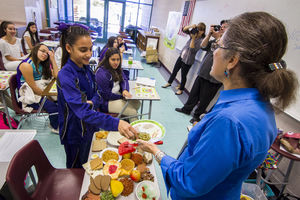
Share On Social!
Carondelet Health Network, which currently operates Holy Cross Hospital, and funded by a 2010 donation from Dr. Harold and Mrs. Nancy Cunningham offers health classes to young Latino students. The classes are often given as teleconferences and involve multiple schools in Southern Arizona simultaneously, but the Desert Shadows class was in-person, reports
During the class, Gwen Gallegos (a diabetes educator) sketched out the food and lifestyle choices that can significantly decrease the chances of the young girls developing diabetes, a chronic illness that can lead to a host of complications, including heart and kidney failure, amputations and blindness.
“With kids, our whole goal is diabetes prevention and just making children aware of what they eat and their foods,” Gallegos said of the program, which has been in operation for about five years. “I think it’s just very important to increase awareness of diabetes and the high risk that we run because of our ethnicity here in Nogales.”
According to data from Health and Human Services, Latinos are 1.7 times more likely to be diagnosed with diabetes than “non-Hispanic whites,” and are 1.5 times more likely to die from complications of the disease. In Santa Cruz County, where more than 80 percent of residents are Latino, diabetes was the sixth-leading cause of death, according to a 2013 Holy Cross community health study. Nearly 10 percent of residents had been diagnosed with the disease in 2012, according to data from the Arizona Department of Health Services.
Soda, spicy Cheetos, Takis and other high-carbohydrate, low-nutrient snacks popular with young people were in Gallegos’ crosshairs Thursday morning. For a moment, she also leveled criticism at “chamoy,” the popular savory sauce made from pickled fruits. Upon closer inspection from Gallegos however, it is fairly low in sugar and soon regained her seal of approval.
“OK, you can have chamoy,” she said. “But not your hot Cheetos.”
After diet, the talk turned to exercise, the other critical component of diabetes prevention, according to Gallegos. According to the Centers for Disease Control and Prevention, regular exercise and eating more fresh fruits, vegetables and high-fiber whole grains and fewer sugary, high-fat foods can significantly reduce the risk of developing diabetes and reduce blood sugars for those already diagnosed.
That message, Gallegos said, is much easier to get across to young people before lifelong eating habits are established and their health consequences have started surfacing.
By The Numbers
142
Percent
Expected rise in Latino cancer cases in coming years



